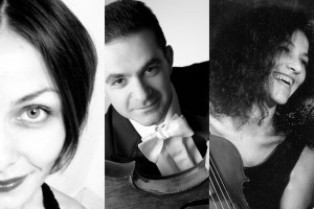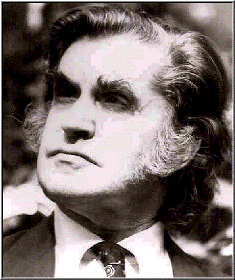From Music in Cincinnati
A Day to Remember at HUC
Jan 18, 2011 - 10:38:08 AM
 The Constella Trio. Left ro right: violinist Tatiana Berman, cellist Ilya Fnkelshteyn and violist Yael Senamaud |
The birthday belonged to Bonia Shur, 88, Director of Liturgical Arts (emeritus) at HUC. The debut was by the Constella Trio, violinist Tatiana Berman, violist Yael Senamaud and cellist Ilya Finkelshteyn. The world premiere was Shur’s “Kol Nidre” for solo viola performed by Senamaud.
The chapel was full to overflowing for the late afternoon concert, and extra chairs had to be moved in to accommodate the crowd. All of which augured well for what was also the inauguration of a new concert series at Scheuer Chapel. It is a welcoming space, with well-balanced acoustics that have served chamber music well in the past. One looks forward to upcoming events.
 Bonia Shur |
Born in Latvia, Shur escaped the Nazi invasion, fought in the Russian army in World War II and lived in a kibbutz in Israel before immigrating to the U.S. in 1960. He settled in Cincinnati when he took up his post at HUC in 1974. He and his wife and collaborator, choreographer Fanchon Schur, were warmly greeted by the Scheuer Chapel crowd.
There was an interpolation on the program occasioned by the Cincinnati Pops matinee concert downtown at Music Hall, which delayed Finkelshteyn’s arrival at Scheuer (he is principal cellist of the Cincinnati Symphony and Pops Orchestras). No problem. Berman and Senamaud filled in with the Duo for Violin and Viola in G Major by Mozart – and very handily, too, for an on-the-spot command performance. Their blend was delicious, Berman playing on a 1770 Joannes Gagliano violin on loan from Jules Azzi. There was plenty of energy and propulsion in the outer movements and a lovely, arioso-like slow movement.
“There’s a cellist in the house,” announced host Jonathan Cohen, Director of The Ethics Center and Outreach Education at HUC, introducing Finkelshteyn, who joined Berman and Senamaud in a supple reading of Schubert’s one-movement Trio in B-flat Major, D.471. They followed with Beethoven’s Trio Op. 9, No. 2 in D Major. Beethoven’s four-movement, thorough-going work showed the Constella Trio to be a hndsome addition to the local chamber music scene, where string trios are less represented than string quartets and ensembles with piano. Finkelshteyn’s svelte tone complemented the higher voices beautifully, and there was a real sense of camaraderie within the group. Everyone sang in the slow movement and joined forces in the verve and merriment of the Rondo Allegro finale.
Highlight of the program was Czech composer Gideon Klein’s String Trio, written in 1944, when Klein was in charge of musical activities at Terezin concentration camp. It is an amazing work, a beacon amid the darkness, penned just two weeks before he was deported for Auschwitz at the age of 26.
A cheerful opening movement, capped by a spreading cello chord gave way to a set of variations on a Moravian tune, the heart of the work and its longest movement. Lest anyone get too introspective, however, the trio closes with a short, sassy finale, a rustic dance announced with stamina by Berman.
For reasons of time, the Trio closed with the final movement of Erno Dohnanyi’s Serenade, Op. 10, rather than the complete work. It is upbeat music -- literally upbeat, at the beginning, where scampering sixteenth notes follow a declamatory chord. It was fun to follow along and in particular, to hear Finkelshteyn set up Berman’s restatement of the gutsy Hungarian theme high on her violin’s lowest string.
The concert was preceded by a tribute to Shur, including a slide show, presentation of HUC’s Lifetime Achievement Award by Dean Ken Ehrlich and a proclamation from the faculty by faculty chair Richard Sarason.